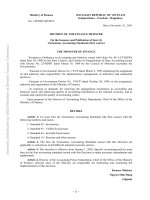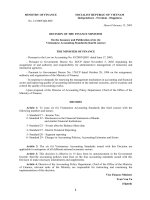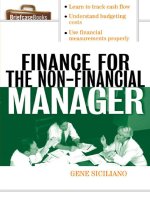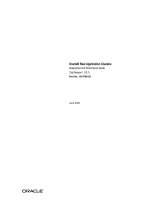Tài liệu Strips. Arbitraging The Eurodollar Cash And Futures Markets(pdf) docx
Bạn đang xem bản rút gọn của tài liệu. Xem và tải ngay bản đầy đủ của tài liệu tại đây (96.5 KB, 4 trang )
Strips:
Arbitraging the
Eurodollar Cash
and Futures
Markets
(Updated June 2001)
OPEN
INTERESTS
In December of 1981, the Chicago Mercantile
Exchange (CME) introduced a futures contract
based on 3-month Eurodollar interest rates.
In the nearly twenty years since its inception,
this contract has become one of the most
versatile trading and hedging vehicles offered
on the listed marke t s .The contract re p resents a
$1,000,000, 3-month London Interbank Offered
Rate (LIBOR) deposit. CME Eurodollar futures
a r e cash-settled, t h e re fo re, t h e re is no delive ry of
a cash instrument upon expiration because cash
Eurodollar time deposits are not transferable.
Of the contract’s many uses, one of the most
significant has been by arbitrageurs in the money
markets who often combine cash and futures
positions to create a synthetic instrument called
a “strip.” Many of the trades in the quarterly
Eurodollar futures contracts are devoted to
these strategies. A strip can mean combining
cash deposits (borrowings) with a long (short)
position in the futures contracts. Such a trade is
initiated when it is determined that the trader
can lock in a higher return or a lower borrowing
cost than are otherwise available in a cash-only
money market transaction.The term “strip” is
derived from the practice of using two or more
consecutive quarterly futures expirations in
combination with a Eurodollar cash position.
The traders must determine for themselves
whether the spread between the strip interest
rate and the cash-only transaction is wide
enough to make such a trade worthwhile. Below,
we will calculate a strip rate using actual market
rates, but first it might be beneficial to review
how Eurodollar futures are priced.
On April 19, 2 0 0 0 , the September 2000 Euro d o l l a r
futures traded at an index price of 93.21.The
CME calculates this price by subtracting the ED
interest rate (in this case, 6.79%) from 100.
Although the contract is referred to as 3-month
Eurodollar futures, it did not match that day’s
prevailing cash 3-month LIBOR rate of 6.31%.
The futures contract is meant to represent a
3-month implied forward rate on the date of
the contract’s expiration on September 18, 2000,
or 152 days hence.
To illustrate how closely the Eurodollar futures
will track the implied forward rates, it might be
useful to derive a 3-month forward Eurodollar
rate.We can then compare this rate to that of
the September futures contract, whose rate is
meant to match that of a 3-month cash deposit
which settles on September 20.The futures
contract is based on a 90-day rate (and there-
fore a constant $25 per $.01 change in price),
even though the period actually covered by the
futures contract may very well be different.
Recognition of this potential mismatch in basis
point values between the futures contract and
the deposit to be hedged will influence the nu m b e r
of contracts used to hedge a given exposure.
1
Strips:
Arbitraging the Eurodollar
Cash and Futures Markets
Updated June 2001
is relatively simple, as the equation below shows.
STRIP % =
{ [ 1 + R c a s h ( n / 3 6 0 ) ] [ 1 + R f u t u res(t/360)] – 1}360/n+t
This equation is the basic method for deriving a
strip rate within one year.The maturity of the
first cash deposit (or borrowing) is represented
by “n.” This first cash transaction is also known
as the “front tail” or “stub,” which is multiplied
by a cash interest rate (Rcash) for that period.
The second part of the equation is the rate and
tenure that the first futures contract represents.
The figure “t” re p resents the time period, in day s ,
between the settlement of the nearby and the
next maturing quarterly futures contract.
Following this would be further components
representing other futures contracts in the strip.
The trader can compare the approximation that
the strip yield re p resents to an actual cash marke t
rate to see if a combination of cash and futures
will outperform a cash-only trade.
For example, we can derive a strip rate for the
morning of April 19, 2000. We assume that a
trader has acquired funds and can place them
at LIBOR for a period of 11 months ending on
March 20, 2001.The strip will involve placing
funds in a 2-month cash deposit at LIBOR of
6.21% and purchasing June 2000 Eurodollar
futures contracts at 93.395 (6.605%), September
2000 at 93.21 (6.79%), and December 2000 at
93.05 (6.95%).The mechanics of the long strip
involve placing the cash deposit for a period that
runs up to two days following the expiration of
the first long futures contract — in this case,
June 21, 2000, 63 days hence. In theory, after the
first futures contracts are sold off, the cash
deposit will be rolled over for a period corre-
sponding to the length of time between the June
settlement on June 21, and the September
settlement on September 20. It is assumed that
this process continues throughout the expiration
of the December contract when funds will be
placed in the cash market until March 21, 2001.
In the long strip, the whole idea is that you cre a t e
a synthetic asset by using futures.The funds are
initially placed in the cash markets but are rolled
fo r w a rd into new deposits as the futures mature.
If the re i nvestment rate declines, i . e. , f u t u re s
prices rise, this is offset by the futures gains.
If interest rates rise, i . e. , f u t u res prices fall,
the futures losses are offset by the higher
reinvestment rate cash deposits.
Let us consider our proposed transaction.
In the cash market, 11-month LIBOR rates
are 6.80375% on April 19, 2000. Below is the
derivation of the strip rate of 6.84%.
6.84% =
{[1+(.0621)63/360][1+(.06605)91/360][1+(.0679)
91/360][1+ (.0695)91/360] – 1}360/63+91+91+91
The decision to employ a strip depends upon
several factors. In the case above, the higher
strip yield might justify the transaction. It would,
however, also depend on how much basis risk
the investor would accept and whether the
p r emium re c e i v ed by the strip would compensate
for the transaction cost of futures commissions.
The above equation with its futures maturities
of 91,91, and 91 days suggest a uniform number
of days between each settlement. H o weve r,
this is not alw ays the case. Depending on the
ye a r, t h e s e periods could run from 90 to 98 days.
This illustrates the risk that the investor may not
be able to find deposits whose maturities exactly
match futures expirations. It is because of risks
3
We also assume in this example that deposit
transactions settle two business days after trades
a re agre e d , and that deposits mature on the
same calendar date as the settlement,“ n ”
months in the future. Counting days in this manner
from April 19, 2000,the September 2000 futures
expire (or “fix”) in 152 days (on September 18),
and settle in 154 days (on September 20).
The interest rate on the 3-month deposit that
the f u t u res contract re p resents is fixed on
S e p t e m b e r 18, actual funds are received on
September 20, and the deposit matures 91 days
later on December 20; 245 days from April 19.
We assume that an investor should be indiffe re n t
between investing for 245 days,and investing for
154 days and rolling the proceeds for 91 days.
If this is the case, “fair value” for the September
futures contract is the 91-day rate at which a
154-day investment could be rolled at maturity
so that its return equals that of a 245-day invest-
ment made on April 19. LIBOR cash rates are
usually quoted for overnight, one week, and then
in maturities month-to-month up to one year.
The 154- and 245-day periods may seem like
unusual durations for deposits, but these would
correspond to 5-month and 8-month LIBOR
rates. However, the most readily available rates
from banks are usually quarterly rates such as
3-, 6-, 9- and 12-month rates.Therefore, if there
were no readily available markets for these 154-
and 245-day maturities, a linear interpolation
could be performed from the most re a d i ly
available Eurodollar rates.Although they might
not represent the exact rates that a bank might
offer, they do facilitate the derivation of forward
rates.A 154-day rate could be derived from a
6-month rate of 6.52% and a 3-month rate of
6.31% as follows:
6 month = 180 days = .0652
3 month = 90 days = .0631
Total Difference = .002100
Difference/day = .0021/90 days = .000023
154-day rate = 90 day rate + (.000023 x 64
days)
= .063100 + .001472
= .064572 ≈ 6.46%
Similarly, a 245-day rate can be interpolated from
the 6-month rate of 6.52% and a 9-month rate
of 6.72875% to arrive at 6.67%.The forward r a t e
can be derived using the following break-even
formula where r* is the implied forward rate.
[1+.0646(154/360)][1+r*(91/360)]=[1+.0667(245
/360)]
The fo r w a rd rate of r* is 6.84%, which is
extremely close to the rate on April 19 for the
September Eurodollar futures contract of 6.79%
(93.21).At times these forward rates are quite
close to the futures prices while, at other times,
market dynamics may cause the futures prices to
diverge dramatically from cash prices.When the
futures contract expires, the settlement price is
a function of cash LIBOR rates on the last day
of trading, so cash and futures rates converge as
expiration approaches. Futures may look “cheap”
or “ e x p e n s i ve” to cash, and this can assist
hedgers in determining which futures contract
should be bought or sold.Arbitrageurs, usually
large bank dealers, will enter the market to take
advantage of these discrepancies by doing a
strip transaction.
While most traders of strips will utilize computer
s o f t w a re to identify profitable cash/future s
spreads, the process of determining a strip rate
2
such as this that many in the markets may not
put on such a trade unless a premium of 25 to
30 basis points could be guaranteed.The markets
have been heavily arbitraged in recent years and
trades such as this are no longer “easy pickings.”
There are other concerns for investors who
might consider such a trade. In our example,
we restricted ourselves to LIBOR for our deposit
rates. But money can be borrowed and deposits
made at rates such as LIBID and LIMEAN, with
spreads above or below these levels depending
upon the customer’s creditworthiness.While the
example of an 11-month deposit versus a strip
was good for illustrative purposes, the end date
for such a transaction frequently will not match
the implied settlement date of a Euro d o l l a r
f u t u res contract such as March 21, 2 0 0 1 .
However, we must be able to do the strip
transaction starting any day and for any period
of time to match a cash rate, even though there
may not be a convenient end date matching a
CME expiration.
We can address this problem by employing the
same strategy for 12 months instead of only 11.
Assume the investor received funds for one year
until April 19, 2001. The investor could end up
buying additional March 2001 Eurodollar futures
contracts on April 19, 2000 at 93.01 (6.99%).
The previous strip equation would be amended
to include the component for March 2001
futures of [1+(.0699)(29/360)]360/336+29.
This would give us a strip rate of 6.88% versus
a cash one-year LIBOR rate of 6.84%.
The slightly higher strip yield means that this
might be preferable to the straight cash deposit
as a more attractive investment.The strip also
presents us once again with the predicament of
mismatching dates.The contract covers the period
of March 21, 2001 to June 20, 2001.The period
we want to cover is March 21 to April 19, a time
span of 29 days, not the 91 covered by the
futures contract. In this case, we are hedging a
29-day period with a derivative product that
represents a 3-month duration. If a $100 million
position were to be covered, we could try to
achieve dollar equivalency with the futures
contract by purchasing 32 of the March 2001
Eurodollar futures (100MM x 29/91) instead of
approximately 100 that might be employed with
the June, September and December expirations.
The number of contracts might well cover the
face value and duration of the cash position,
but it is an approximation that could be further
fine-tuned. For example, the above case called
for constructing a “ t a i l .” In add i t i o n ,m a ny hedgers
will underweight the size of their hedge slightly
as a function of the tenures of the hedge and
underlying instrument as well as the cost of
financing their margin flows.This adjustment in
their hedge ratio accounts for interest earned
on profits from positive margin flows and intere s t
paid on outflows due to margin calls.
4









